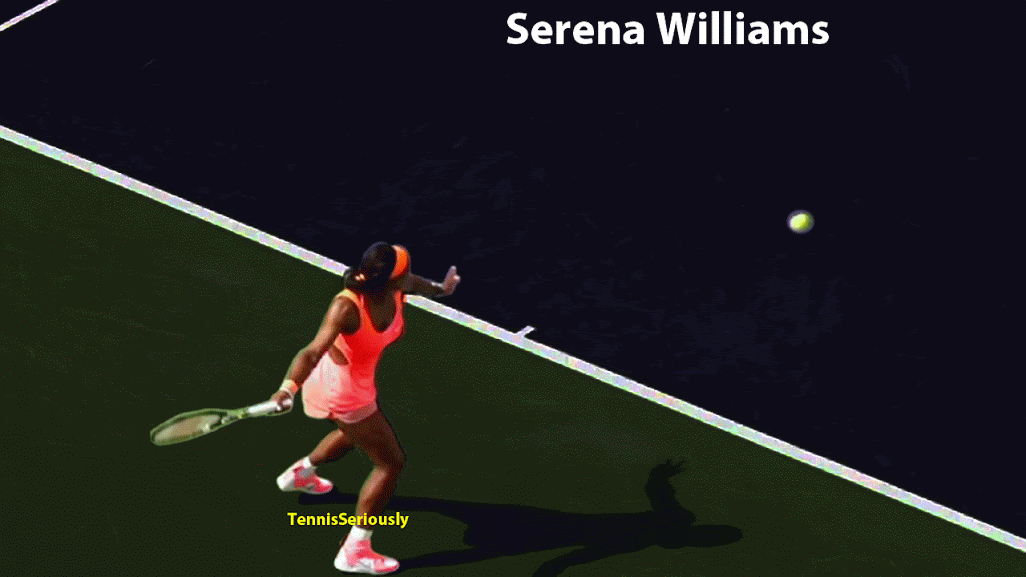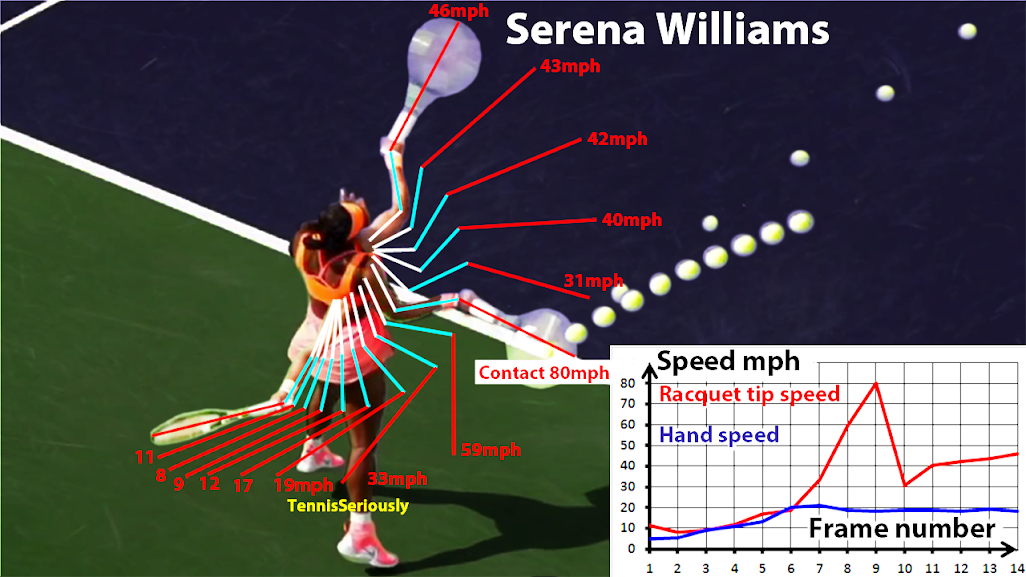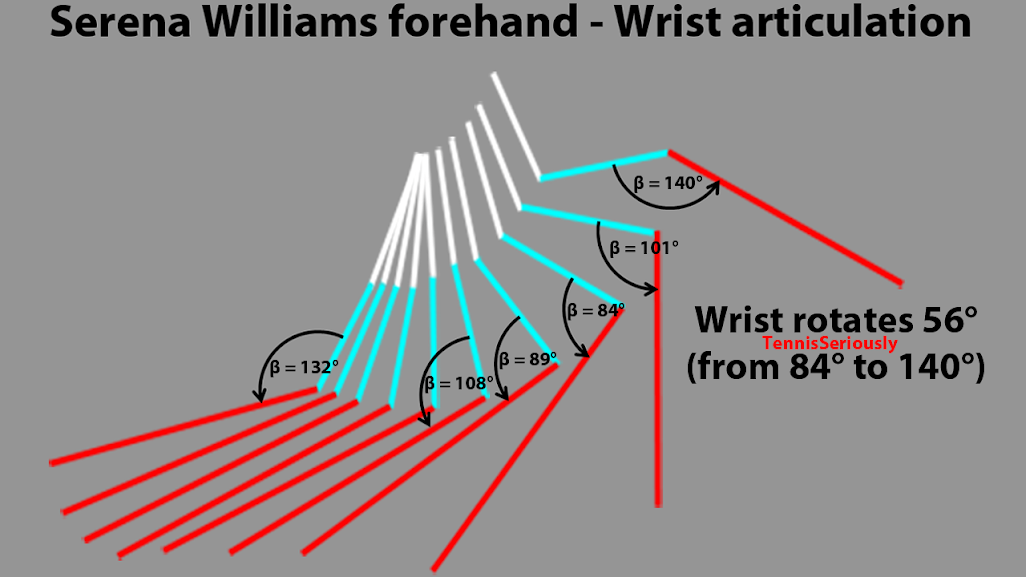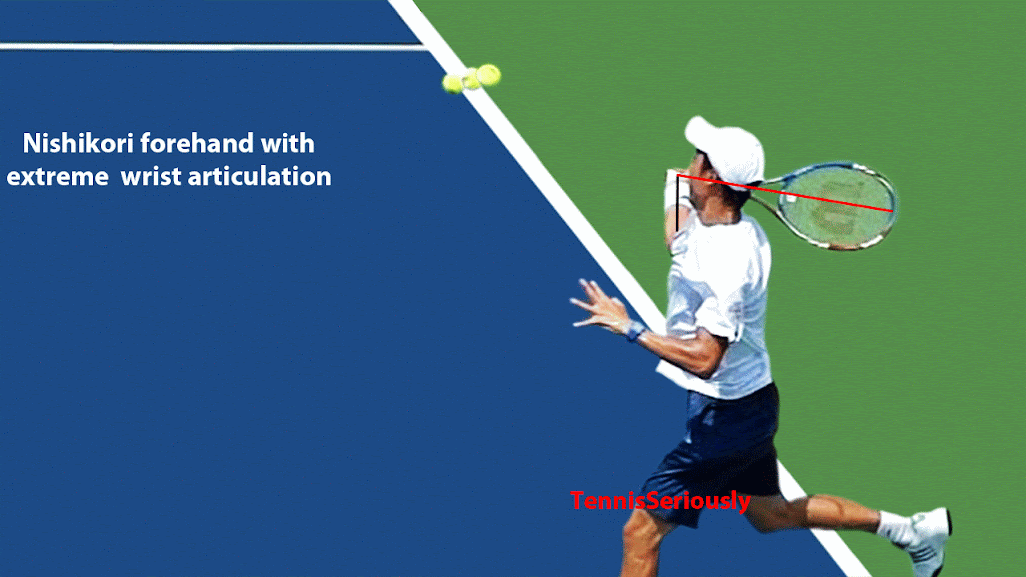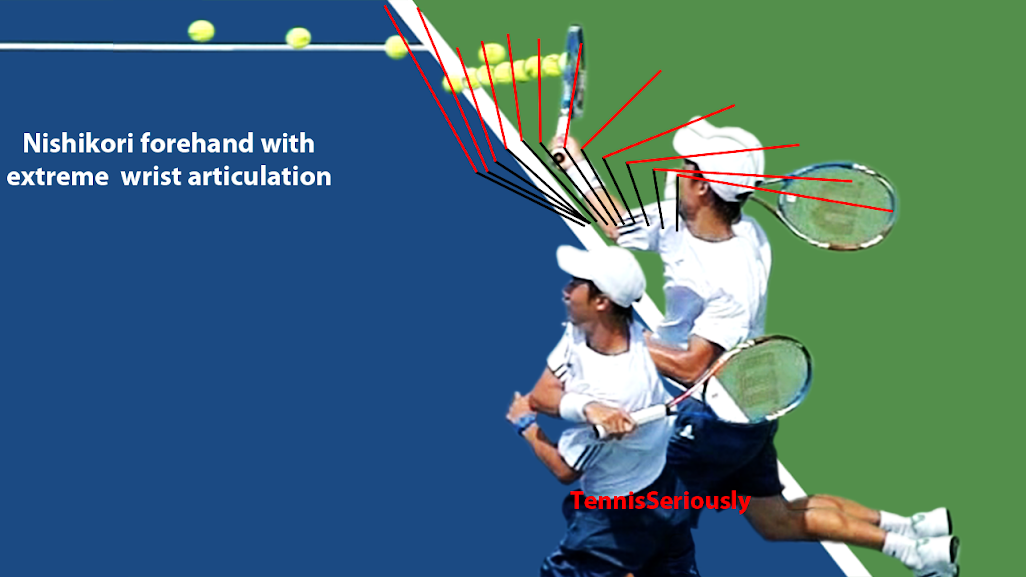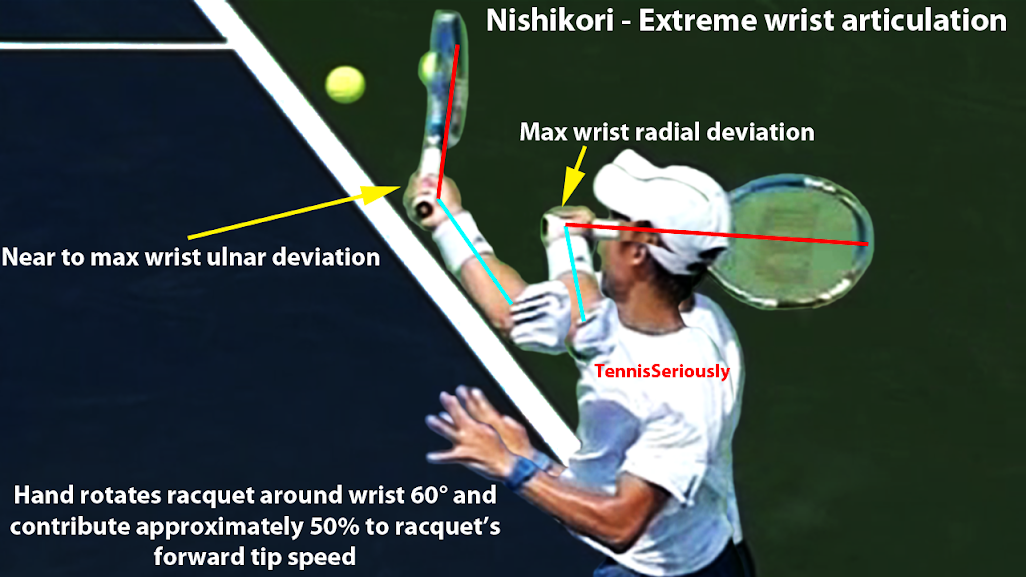Last edited:
You are using an out of date browser. It may not display this or other websites correctly.
You should upgrade or use an alternative browser.
You should upgrade or use an alternative browser.
Serena Williams forehand - Wrist articulation analysis
- Thread starter toly
- Start date
Seems odd that racket tip continues to speed up when hand speed flatens out at frames 6-9.
Are you sure you are measuring hand speed correctly? Do you consider that the hand is changing from a mostly forward direction toward the net to a more sideways direction as it rotates across the body?
I understand that stopping the hand like cracking a whip speeds up the tip of the whip but in a FH the hand continues across the body and into the follow through.
Are you sure you are measuring hand speed correctly? Do you consider that the hand is changing from a mostly forward direction toward the net to a more sideways direction as it rotates across the body?
I understand that stopping the hand like cracking a whip speeds up the tip of the whip but in a FH the hand continues across the body and into the follow through.
In your 2nd photo, I believe the light bluish part of the arm and racket structure is the arm. The place where the bluish segment meets the red segment is the hand (tip of arm and bottom of racket). In the 2nd photo, if you are capturing images at even time intervals; the hand (blue/red joint) has a greater or equal size gap in each frame. Granted, frames 8 through 10 look roughly the same distance which might indicate maintaining the same speed but frames 1 through 8 all look like they accelerate. The relationship between these frames and the graph in photo 1 does not look correct.
The hand rotates the racquet around the wrist with linear speed 40mph, the racquet’s tip has 80mph, so it means the hand/wrist action is the main contributor (50%) to the speed of the Serena’s forehand!!!:shock:
This effect partially explained in Rod Cross article http://www.tennisindustrymag.com/articles/2006/07/wrist_snap_in_the_serve.html
This effect partially explained in Rod Cross article http://www.tennisindustrymag.com/articles/2006/07/wrist_snap_in_the_serve.html
The hand rotates the racquet around the wrist with linear speed 40mph, the racquet’s tip has 80mph, so it means the hand/wrist action is the main contributor (50%) to the speed of the Serena’s forehand!!!:shock:
This effect partially explained in Rod Cross article http://www.tennisindustrymag.com/articles/2006/07/wrist_snap_in_the_serve.html
What does this mean? Are you saying it is wrist flexion?
What does this mean? Are you saying it is wrist flexion?
Serena has semiwestern grip, so it is the wrist ulnar deviation.
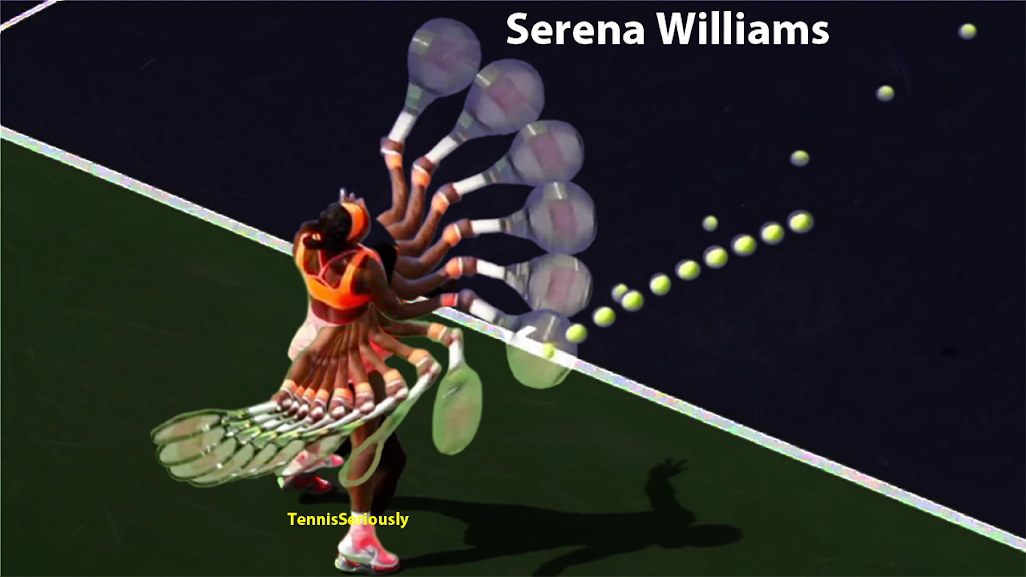
Last edited:
What does this mean? Are you saying it is wrist flexion?
It's the kinetic chain in action - hips rotate and stop, shoulders rotate and slow, arm comes through and slows, wrist comes through with racquet. Otherwise, your hitting with the speed that you can rotate - not very fast.
Serena has semiwestern grip, so it is the wrist ulnar deviation.

When you measure speed in your graphic, what is it relative to? I would have expected wrist movement from ulnar to radial deviation would have produced motion parallel to the face plane, ie topspin rotation. The tip is accelerating but not relative to the net.
It's the kinetic chain in action - hips rotate and stop, shoulders rotate and slow, arm comes through and slows, wrist comes through with racquet. Otherwise, your hitting with the speed that you can rotate - not very fast.
We will have to agree to disagree on this. While there are kinetic chain aspects to the swing, kinetic chain analysis is only accurate for simple two or three lever systems, like golf hitting robots. The body's spine and shoulder structure allows for independent and coupled movements. There is the SSC to consider. Also, as in toly's example, the movement is not purely rotational. There is a vertical aspect to it as well, produced by wrist deviation, which I am not sure is part of the kinetic chain.
When you measure speed in your graphic, what is it relative to? I would have expected wrist movement from ulnar to radial deviation would have produced motion parallel to the face plane, ie topspin rotation. The tip is accelerating but not relative to the net.
Serena does something like that.
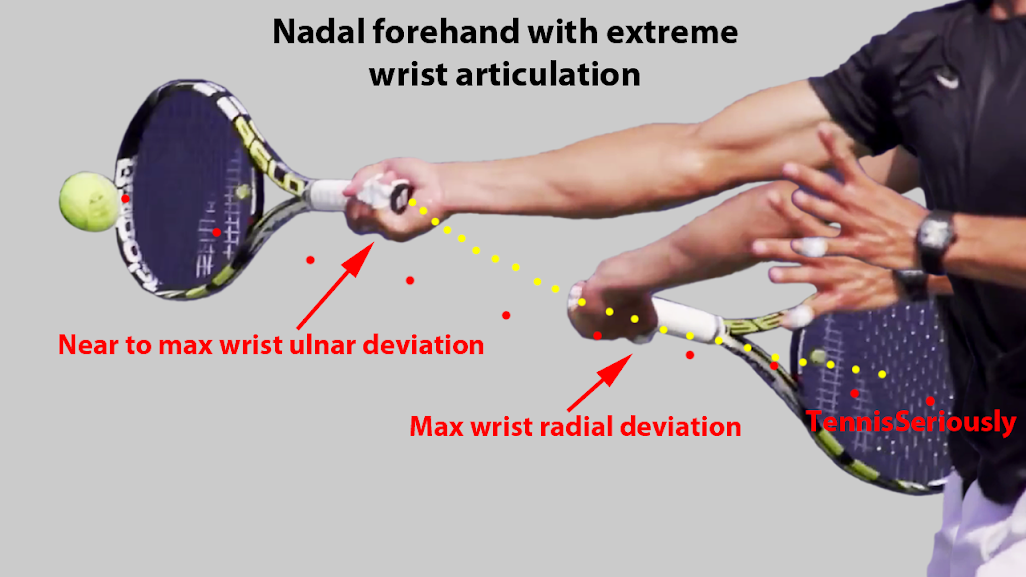
See also video https://youtu.be/rfyDZhNQz8A
Tight Lines
Professional
This just looks wrong to me. Where you have radial deviation, don't you mean ulnar deviation?
Also, where you indicate ulnar deviation, I don't see any deviation. It just looks neutral to me.
Harry
Tight Lines
Professional
It's the kinetic chain in action - hips rotate and stop, shoulders rotate and slow, arm comes through and slows, wrist comes through with racquet. Otherwise, your hitting with the speed that you can rotate - not very fast.
Arm slows? Really? That just sounds wrong to me. Do you have any proof? Even in Toly's image, the arm does not slow. Where do you see that?
Harry
Tight Lines
Professional
It's the kinetic chain in action - hips rotate and stop, shoulders rotate and slow, arm comes through and slows, wrist comes through with racquet. Otherwise, your hitting with the speed that you can rotate - not very fast.
Umm, not quite. The RHS is higher than your arm speed because it's further out from the center of rotation (i.e., your spine in the body).
Harry
This just looks wrong to me. Where you have radial deviation, don't you mean ulnar deviation?
Also, where you indicate ulnar deviation, I don't see any deviation. It just looks neutral to me.
Harry
In last last frame Federer wrist is near to max wrist ulnar deviation.
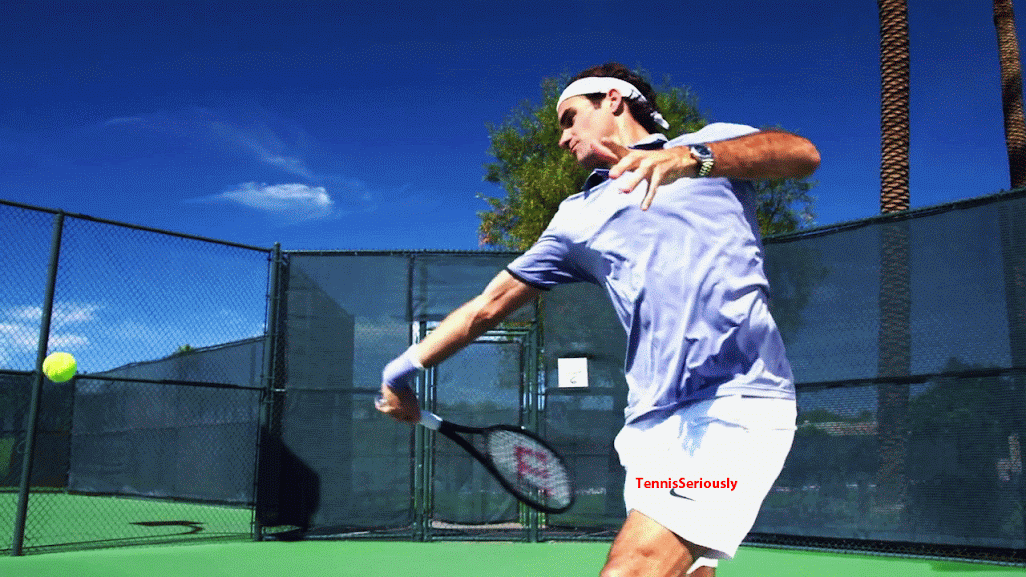
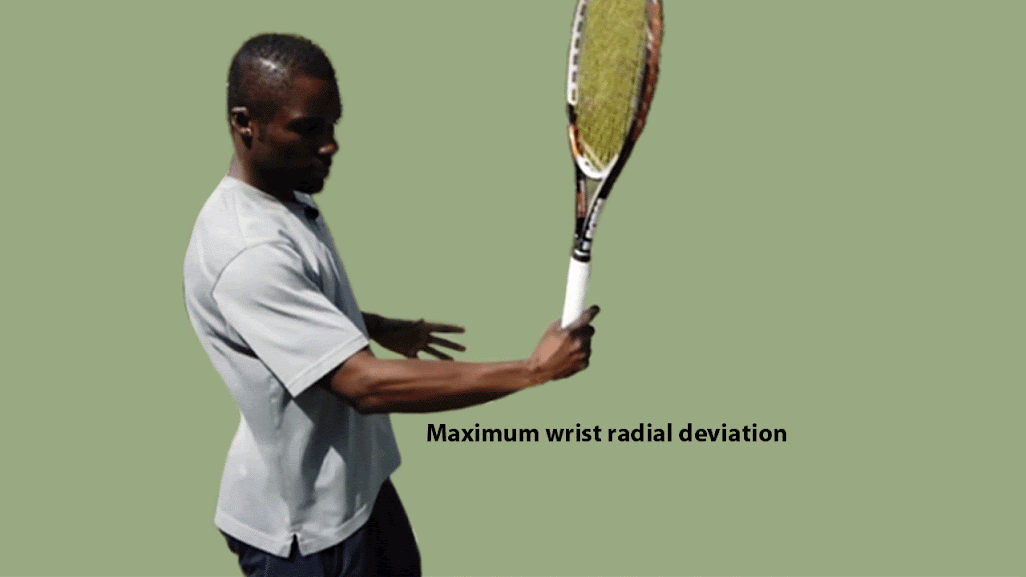
Umm, not quite. The RHS is higher than your arm speed because it's further out from the center of rotation (i.e., your spine in the body).
Harry
The hand speed slows (and then the wrist does its thing) to allow racquet release - that's the point. Of course racquet head will always be faster (except at the lag).
Last edited:
TennisPinkBabe
Rookie
Toly, in the max radial deviation part, how much wrist extension do you think is there, if any?
Arm slows? Really? That just sounds wrong to me. Do you have any proof? Even in Toly's image, the arm does not slow. Where do you see that?
Harry
Hard to see on video but you can see it slowing on that chart above - blue. Plus it makes sense if you believe that the wrist moves with racquet release. Otherwise, they're forcefully moving the wrist 100% without the aid of momentum. Understand that the slowing is not due to actively slowing the arm down, it's a result the outward then across change of direction of the swing - the hand is whipped out and then to the side - at that change in direction, it slows.
Toly, in the max radial deviation part, how much wrist extension do you think is there, if any?
The wrist extension defines a launch angle in vertical plane (elevation angle) and should be stable during forward swing. Nadal keeps constant elevation angle and you want to keep this angle in the max wrist radial deviation position also. But, you can increase extension for higher balls and decrease it for lower ones.

Last edited:
When you measure speed in your graphic, what is it relative to? I would have expected wrist movement from ulnar to radial deviation would have produced motion parallel to the face plane, ie topspin rotation. The tip is accelerating but not relative to the net.
Are you talking about continental grip?
Hard to see on video but you can see it slowing on that chart above - blue. Plus it makes sense if you believe that the wrist moves with racquet release. Otherwise, they're forcefully moving the wrist 100% without the aid of momentum. Understand that the slowing is not due to actively slowing the arm down, it's a result the outward then across change of direction of the swing - the hand is whipped out and then to the side - at that change in direction, it slows.
If you look at the blue lines, it appears that the distance between the blue lines in each frame gets larger up to about contact and then it stays about the same all the way through follow-thru. Wouldn't this indicate the arm/hand speeds up as it near contact and then maintains speed thru the follow-thru? If the time between each frame is the same, then the distance from frame to frame gives us a feel for speed.
You also state the arm/hand goes out and across and I agree. But you say going across slows the arm/hand. That conflicts with the frame by frame analysis too as the distance of the arm movement is about the same through the follow-thru.
I still question the MPH analysis too. The arm is moving forward, upward and across/side and I am not sure Toly's method accounts for the deviations in direction. I do think it is close though.
Personally, I think the change in direction of the hand and the tip of the racket being farther away from the center of rotation account for the increase in racket tip speed. But, I don't think the arm/hand slow.
I also think the terms snap or violent wrist actions could ruin a lot of tennis games. Just keep the wrist loose and let it flow as a stroke and don't snap the wrist and especially don't violently snap the wrist.
I also think the terms snap or violent wrist actions could ruin a lot of tennis games. Just keep the wrist loose and let it flow as a stroke and don't snap the wrist and especially don't violently snap the wrist.
Are you talking about continental grip?
No, I was asking what was the reference point for the MPH figures. The racquet face is moving three dimensionly. Velocity is a one dimensional measure. When yu say the racquet tip i smoving a certain velocity, do you mean measured along its path, which is somewhat circular? Or relative to the net or target line?
Anyway, I was totally wrong in analyzing your graphic. I see what you mean now about going from radial to ulnar deviation and keeping extension constant. I had that totally backward.
It does "feel" like you are whipping the face through by going from low, ie ulnar, to high, ie raidal deviation, but it's obvious now that the opposite is taking place, at least with a western or SW grip.
Chas Tennis
G.O.A.T.
In last last frame Federer wrist is near to max wrist ulnar deviation.


Wrist articulations are coupled for largest forearm to racket angles - large radial deviation accompanies large wrist extension. Large ulna deviation accompanies large wrist flexion.
In the Federer pictures above, the earliest picture for the most bent forearm to racket angle, there is large radial deviation (I think ?) coupled with large wrist extension. For impact, the extension and ulna deviation look more moderate. (The wrist appears to have developed pace from flexing.) These articulations probably depend on grip. Semi-western & western grips would make an interesting comparison.
These 'coupled' wrist articulations are also apparent on the serve with large radial deviation along with large extension coupled in the racket drop and large ulna deviation along with large wrist flexion angles coupled after impact.
When the wrist lags (during the stretch shortening cycle) it tends to go toward the ends of the ranges of motion for both articulations, for the serve, wrist extension and radial deviation.
You can try it with your wrist and see how these 'coupled' wrist motions go together.
Reference on wrist joint 'couplings' -
Coupling between wrist flexion–extension and radial–ulnar deviation
Zong-Ming Licorrespondenceemail
,
Laurel Kuxhaus
,
Jesse A. Fisk
,
Thomas H. Christophel
Received: June 17, 2004; Accepted: October 4, 2004; Published Online: December 06, 2004
DOI: http://dx.doi.org/10.1016/j.clinbiomech.2004.10.002
showArticle Info
Abstract
Background. Conventional wrist joint goniometry evaluates range of motion in isolated directions. The coupling between wrist flexion–extension and radial–ulnar deviation was investigated.
Methods. Ten healthy young male subjects performed wrist flexion–extension, radial–ulnar deviation, and circumduction motions. Flexion–extension and radial–ulnar deviation angles were computed from the coordinates of surface markers attached to the forearm and hand. A motion analysis system recorded marker motion.
Findings. During radial–ulnar deviation, the amount of accompanying flexion–extension movement was linearly related to the amount of radial–ulnar deviation. The secondary (flexion–extension) range of motion (48.3°) was about 75% of the primary (radial–ulnar deviation) range of motion (55.1°). During the flexion–extension task, the coupling was less linear. The motion range in radial–ulnar deviation (21.2°) was about 20% of the primary (flexion–extension) range of motion (108.3°). The radial–ulnar deviation and flexion–extension motions combined extension with radial deviation, and flexion with ulnar deviation. The convex hull of the flexion–extension and radial–ulnar deviation angles during circumduction was “egg-shaped” and asymmetric with respect to the anatomically defined flexion–extension and radial–ulnar deviation axes. Wrist position in one direction strongly influenced the range of motion in the other. Maximum range of motion in flexion–extension occurred with the wrist near the neutral radial–ulnar deviation position, and vice versa. Wrist deviation from neutral position in one direction diminished wrist range of motion in the other.
Interpretation. Wrist movements in flexion–extension and radial–ulnar deviation are coupled. Maximal wrist range of motion is near the neutral position. To account for the naturally coupled wrist motion in work station design and rehabilitation, the wrist should be placed at a neutral position.
Last edited:
If you look at the blue lines, it appears that the distance between the blue lines in each frame gets larger up to about contact and then it stays about the same all the way through follow-thru. Wouldn't this indicate the arm/hand speeds up as it near contact and then maintains speed thru the follow-thru? If the time between each frame is the same, then the distance from frame to frame gives us a feel for speed.
You also state the arm/hand goes out and across and I agree. But you say going across slows the arm/hand. That conflicts with the frame by frame analysis too as the distance of the arm movement is about the same through the follow-thru.
I still question the MPH analysis too. The arm is moving forward, upward and across/side and I am not sure Toly's method accounts for the deviations in direction. I do think it is close though.
Yes, you could say that - the hand accelerates up to contact and then stops accelerating. That may be more of what's happening actually and this would still cause the racquet head to release (or go towards making a straight line with the arm). I wonder if Toly has done one of these on Federer - all the speed changes would be more pronounced and easier to see.
mntlblok
Hall of Fame
I also think the terms snap or violent wrist actions could ruin a lot of tennis games. Just keep the wrist loose and let it flow as a stroke and don't snap the wrist and especially don't violently snap the wrist.
Whilst I don't disagree, it seems to me that when Jack Sock does it, violence would seem an understatement.
Whilst I don't disagree, it seems to me that when Jack Sock does it, violence would seem an understatement.
I don't know - sock is Western so doesn't do much wrist flexion but does ulnar deviate. His racquet never points at the other side of the court either.
He comes at the ball with the heel of his hand as opposed to Federer, who is Eastern, and comes at it with the underside of the wrist.
sock
https://www.youtube.com/watch?v=CWqrVOW_-SE
Federer
https://www.youtube.com/watch?v=Af-nLzGh3eM
@Chas_tennis,
Semiwestern grip: Wrist ulnar deviation moves a racquet in direction perpendicular to the racquet strings bed and produce just ball’s speed without any spin. The wrist flexion/extension changes elevation angle.
Continental grip: Wrist ulnar/radial deviation can be used for spin. If wrist is near to max ulnar deviation position the wrist flexion can effectively generates ball’s speed.
Federer has eastern grip, so the wrist ulnar deviation and flexion can both create ball spin and speed.
About coupling:
If wrist flexion/extension is max, then you cannot use wrist ulnar/radial deviation at all. However, usually wrist extension/flexion around contact is near to neutral, thus we can ignore coupling.

Semiwestern grip: Wrist ulnar deviation moves a racquet in direction perpendicular to the racquet strings bed and produce just ball’s speed without any spin. The wrist flexion/extension changes elevation angle.
Continental grip: Wrist ulnar/radial deviation can be used for spin. If wrist is near to max ulnar deviation position the wrist flexion can effectively generates ball’s speed.
Federer has eastern grip, so the wrist ulnar deviation and flexion can both create ball spin and speed.
About coupling:
If wrist flexion/extension is max, then you cannot use wrist ulnar/radial deviation at all. However, usually wrist extension/flexion around contact is near to neutral, thus we can ignore coupling.

Last edited:
Whilst I don't disagree, it seems to me that when Jack Sock does it, violence would seem an understatement.
What can you say about Nishikori forehand?
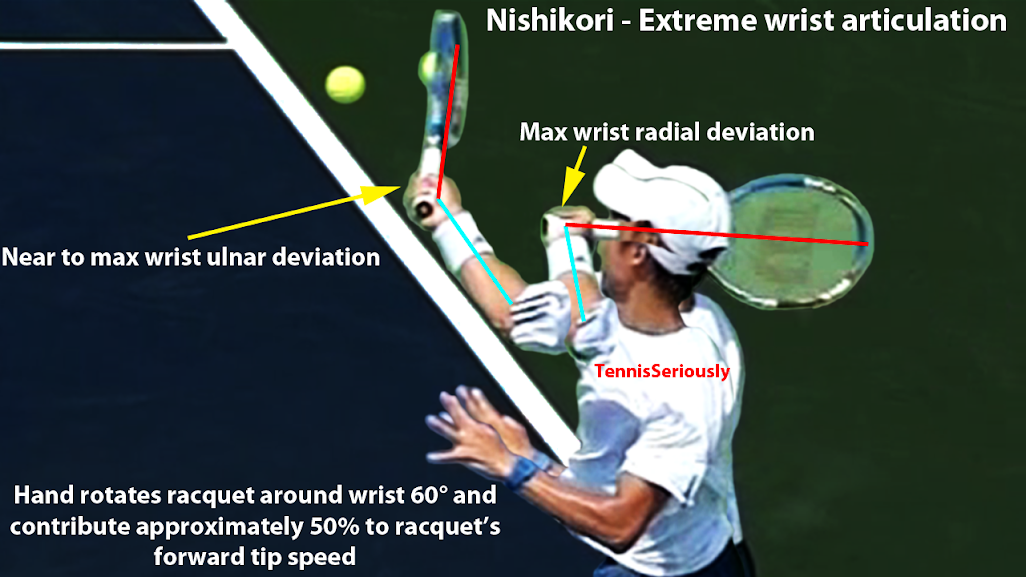
Tight Lines
Professional
Toly,
I still think you got it backwards. Ulnar deviation occurs when going from backswing to forward swing.

At impact, I don't see any deviation. The wrist is neutral in terms of radial and ulnar deviation.
Harry
I still think you got it backwards. Ulnar deviation occurs when going from backswing to forward swing.

At impact, I don't see any deviation. The wrist is neutral in terms of radial and ulnar deviation.
Harry
Tight Lines
Professional
Yes, you could say that - the hand accelerates up to contact and then stops accelerating. That may be more of what's happening actually and this would still cause the racquet head to release (or go towards making a straight line with the arm). I wonder if Toly has done one of these on Federer - all the speed changes would be more pronounced and easier to see.
I am sorry I have to disagree with you again. In a "normal" forehand stroke, the racket never makes a straight line with the arm at impact. The only time this happens is if you are trying to slap at the ball to generate extra racket head speed, i.e., a kill shot.
The feel of a release IMO is the ISR, not release in the sense of the wrist going from extension to flexion.
Harry
Last edited:
mntlblok
Hall of Fame
I will never understand the full western forehand, but I once heard it described as being like skipping a stone. The deviations would look different with that thought in mind. . .Toly,
I still think you got it backwards. Ulnar deviation occurs when going from backswing to forward swing.

At impact, I don't see any deviation. The wrist is neutral in terms of radial and ulnar deviation.
Harry
mntlblok
Hall of Fame
What can you say about Nishikori forehand?
Looks like he knows what he's doing, but Sock looks to me like body parts might come flying off like Phil's club head today. . .
Toly,
I still think you got it backwards. Ulnar deviation occurs when going from backswing to forward swing.

At impact, I don't see any deviation. The wrist is neutral in terms of radial and ulnar deviation.
Harry
Try to reproduce Kevin Garlington exercise.

If you succeeded, apply 90° forearm supination and repeat Kevin Garlington exercise in horizontal plane. It’s really easy.
Yes, you could say that - the hand accelerates up to contact and then stops accelerating. That may be more of what's happening actually and this would still cause the racquet head to release (or go towards making a straight line with the arm). I wonder if Toly has done one of these on Federer - all the speed changes would be more pronounced and easier to see.
This is Federer
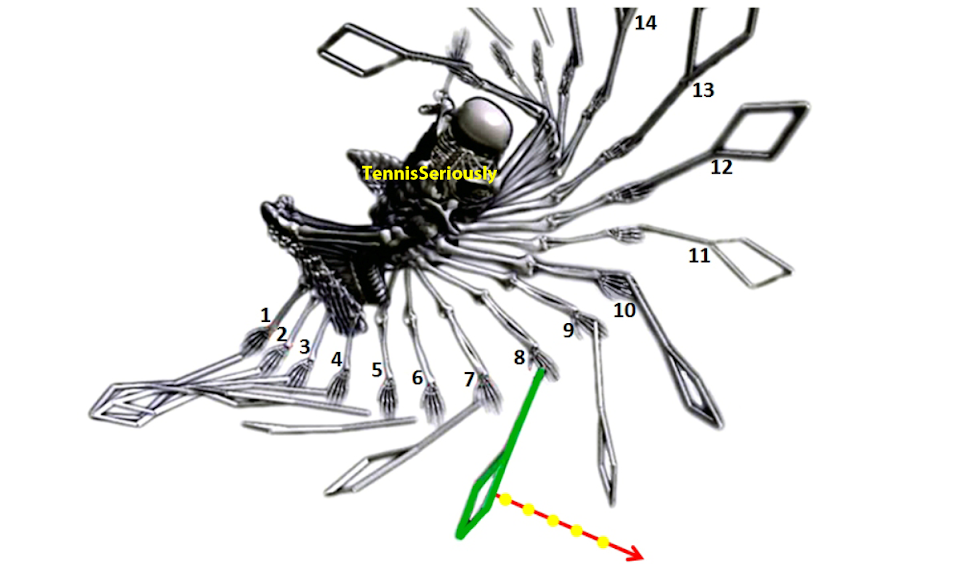
I am sorry I have to disagree with you again. In a "normal" forehand stroke, the racket never makes a straight line with the arm at impact. The only time this happens is if you are trying to slap at the ball to generate extra racket head speed, i.e., a kill shot.
The feel of a release IMO is the ISR, not release in the sense of the wrist going from extension to flexion.
Harry
This position is easily seen in the Federer graphic above.
This is Federer

Thanks
Just from eyeballing it, I see an increase in acceleration up to contact and then slight slowing - maybe increasing at end arm wrap around but that's inconsequential.
So everybody who's trying to kill it with the follow through is in a losing battle.
ShooterMcMarco
Hall of Fame
This position is easily seen in the Federer graphic above.
He's talking about at impact. Fed is making contact with the ball with his wrist laid back and not in a straight line as seen on segment 12 of the picture.
He's talking about at impact. Fed is making contact with the ball with his wrist laid back and not in a straight line as seen on segment 12 of the picture.
It's not always at impact, that was never the argument. It depends on where the ball is in relation to the body - if you're reaching out to the right it might be in a straight line at contact - if you're hitting more forward you'll have the wrist cocked back at impact. The argument is that the wrist is moving into contact, that it is a part of the stroke and not some artifact that doesn't matter. Just look at the graphic above, Federer's racquet is going from very lagged to less lagged. It is quite possible to hit the forehand with a fixed wrist and it's also possible to hit it with a moving wrist. Why would you want to keep the power of wrist release out of the stroke?
Last edited:
ShooterMcMarco
Hall of Fame
It's not always at impact, that was never the argument. It depends on where the ball is in relation to the body - if you're reaching out to the right it might be in a straight line at contact - if you're hitting more forward you'll have the wrist cocked back at impact. The argument is that the wrist is moving into contact, that it is a part of the stroke and not some artifact that doesn't matter. Just look at the graphic above, Federer's racquet is going from very lagged to less lagged. It is quite possible to hit the forehand with a fixed wrist and it's also possible to hit it with a moving wrist. Why would you want to keep the power of wrist release out of the stroke?
All really good points you've made...although the first thought that comes to mind is when a player has timing issues or is playing in the wind. They might opt for a fixed wrist because its one less variable to worry about.
All really good points you've made...although the first thought that comes to mind is when a player has timing issues or is playing in the wind. They might opt for a fixed wrist because its one less variable to worry about.
I keep a fixed wrist on difficult balls where I'm rushed - balls that bounce close to me, etc.. It's a way to get a tough ball back but if you have time - let the wrist go.
Chas Tennis
G.O.A.T.
What about stats for the forehand wrist techniques?
Here is a video that appears to have minimal wrist articulation.
There's a lot of variety in the forehands that we can find in videos.
In a match, players are often hitting shots that are difficult and don't allow any sort of good form. Forget those for technique.
In practice, they are often warming up, but sometimes using pace.... Forget the easy practice shots, some of the heavy pace strokes are good.
We'd all like to have statistics showing what the players choose to do during a match when they are comfortable handling a ball and want to add pace. That is probably representative of the best technique.
Is that Nishikori forehand typical for his forehands?
So what wrist techniques do you think the majority of current high level players are choosing to do with their wrists on forehands? Any rough guesses for stats?
Here is a video that appears to have minimal wrist articulation.
There's a lot of variety in the forehands that we can find in videos.
In a match, players are often hitting shots that are difficult and don't allow any sort of good form. Forget those for technique.
In practice, they are often warming up, but sometimes using pace.... Forget the easy practice shots, some of the heavy pace strokes are good.
We'd all like to have statistics showing what the players choose to do during a match when they are comfortable handling a ball and want to add pace. That is probably representative of the best technique.
Is that Nishikori forehand typical for his forehands?
So what wrist techniques do you think the majority of current high level players are choosing to do with their wrists on forehands? Any rough guesses for stats?
Last edited:
Raul_SJ
G.O.A.T.
Wrist articulations are coupled for largest forearm to racket angles - large radial deviation accompanies large wrist extension. Large ulna deviation accompanies large wrist flexion.
In the Federer pictures above, the earliest picture for the most bent forearm to racket angle, there is large radial deviation (I think ?) coupled with large wrist extension. For impact, the extension and ulna deviation look more moderate. (The wrist appears to have developed pace from flexing.) These articulations probably depend on grip. Semi-western & western grips would make an interesting comparison.
This article says there is maximal wrist extension at contact. No contribution from wrist flexion.
http://www.feeltennis.net/forehand-wrist-lag/
Before I explain the different types of drop techniques and wrist actions on the forehand, I want to explain one concept that I call a stable wrist.
A wrist is stable when it is in the full extension – so it’s fully laid back.
This stable / fully laid back position of the wrist – which is at around 90 degrees angle in relation to the forearm – happens at some point in the forward swing and it stays there until the contact.

… and this same “forearm to wrist” position is the same at contact point.
Before I explain the different types of drop techniques and wrist actions on the forehand, I want to explain one concept that I call a stable wrist.
A wrist is stable when it is in the full extension – so it’s fully laid back.
This stable / fully laid back position of the wrist – which is at around 90 degrees angle in relation to the forearm – happens at some point in the forward swing and it stays there until the contact.

… and this same “forearm to wrist” position is the same at contact point.
Chas Tennis
G.O.A.T.
This article says there is maximal wrist extension at contact. No contribution from wrist flexion.
http://www.feeltennis.net/forehand-wrist-lag/
Before I explain the different types of drop techniques and wrist actions on the forehand, I want to explain one concept that I call a stable wrist.
A wrist is stable when it is in the full extension – so it’s fully laid back.
This stable / fully laid back position of the wrist – which is at around 90 degrees angle in relation to the forearm – happens at some point in the forward swing and it stays there until the contact.

… and this same “forearm to wrist” position is the same at contact point.
I don't know much about this issue and impacting with the wrist near the end of the wrist's range of motion.
When I bend my wrist the ends of the range of motion seem pretty firm, especially for ulna deviation. I don't like the approach of impacting the ball when the wrist is at the end of its range of motion.
Try this, put your wrist in maximum ulna deviation and do wrist extension. Now maximum radial deviation and try the extension. The ulna deviation stops my extension earlier than the radial deviation.
For this issue your would have to do a careful study of what is out there for forehands. That might take quite an effort because there is a lot of variety for the forehand. Toly was interested in this wrist issue and you may find some of his wonderful composite pictures are very informative. These include above camera views. His website is under Anatoly Antipin.

Halep at first appears to have a right angle wrist extension but her forearm is toward the camera and appears shortened. That makes the forearm-to-racket angle falsely look more like a right angle.
The best views for this issue are from above. Toly has studied this issue including with above views when he could find them. At times, Toly liked to investigate the exceptions to the norm.
Toly was viewing the forum as late as Jan 2017. I was hoping that he would come back.
Last edited:
Chas Tennis
G.O.A.T.
Im not talking about wrist extension/flexion, but ulnar deviation!
This thread has some work by Toly that goes into detail with Serena's forehand, a post on Nadal's forehand, Nishikori's and others. Wrist articulations are complicated and high speed videos have to be carefully selected to try to isolate one defined wrist joint motion.
One complication is that maximum extension pairs with radial deviation (RD) and maximum flexion pairs with ulnar deviation (UD). You can try that by doing max extension and max flexion and seeing whether UD or RD is most comfortable and moves farthest. Wrist joint articulations rarely occur one at a time. I found a publication on this pairing, see post #24.
I found Toly creditable and he created the most informative pictures of high speed video frames that I have seen. I look to this Toly composite display, I believe the information and Toly's analysis. You are interested in this subject and have been studying it.

I hope that I can interest you in doing high speed videos of your wrist motions and comparing them to some of Toly's analyses and other pro forehands.
I avoid some issues that are difficult for high speed video to answer and look to find things that are easy to see and answer.
There is a tricky thing about the term usage for the joints of the body. They can be used for both position of a joint and the motion of a joint. For example, the wrist joint might be in a position of 5 degrees radial deviation and be doing the wrist joint motion of ulnar deviation (going toward maximum UD). It took me a few years to pin down that dual usage.
This post #11 describes how Toly viewed Serena's wrist "articulations" on the forehand.
Serena Williams forehand - Wrist articulation analysis
Here is video https://youtu.be/vp6EgRqLMSo
 tt.tennis-warehouse.com
tt.tennis-warehouse.com
Another post. I believe that Toly's first sentence applies to the Western Grips with the racket shaft horizontal.
The wrist extension defines a launch angle in vertical plane (elevation angle) and should be stable during forward swing. Nadal keeps constant elevation angle and you want to keep this angle in the max wrist radial deviation position also. But, you can increase extension for higher balls and decrease it for lower ones.

Google: serena williams forehand anatoly antipin
Last edited:
peoplespeace
Professional
Cool work by Toly. However, I dont agree that the wrist is or should be in a fixed position all through the forward swing. Some player eg have the wrist completely laid back when the forward swing begins but hit the ball at a low or middle hight which is not possible with a laid back wrist (unless the rachet is tiltet/pointing downwards at contact) so the wrist must necessarily be going towards flexing up to contact. The is also consistant with a completely flexed wrist at the end of followthrough plus, importantly, it facilitates ulnat deviation before and through contact.This thread has some work by Toly that goes into detail with Serena's forehand, a post on Nadal's forehand, Nishikori's and others. Wrist articulations are complicated and high speed videos have to be carefully selected to try to isolate one defined wrist joint motion.
One complication is that maximum extension pairs with radial deviation (RD) and maximum flexion pairs with ulnar deviation (UD). You can try that by doing max extension and max flexion and seeing whether UD or RD is most comfortable and moves farthest. Wrist joint articulations rarely occur one at a time. I found a publication on this pairing, see post #24.
I found Toly creditable and he created the most informative pictures of high speed video frames that I have seen. I look to this Toly composite display, I believe the information and Toly's analysis. You are interested in this subject and have been studying it.

I hope that I can interest you in doing high speed videos of your wrist motions and comparing them to some of Toly's analyses and other pro forehands.
I avoid some issues that are difficult for high speed video to answer and look to find things that are easy to see and answer.
There is a tricky thing about the term usage for the joints of the body. They can be used for both position of a joint and the motion of a joint. For example, the wrist joint might be in a position of 5 degrees radial deviation and be doing the wrist joint motion of ulnar deviation (going toward maximum UD). It took me a few years to pin down that dual usage.
This post #11 describes how Toly viewed Serena's wrist "articulations" on the forehand.
Serena Williams forehand - Wrist articulation analysis
Here is video https://youtu.be/vp6EgRqLMSott.tennis-warehouse.com
Another post. I believe that Toly's first sentence applies to the Western Grips with the racket shaft horizontal.
Google: serena williams forehand anatoly antipin
Chas Tennis
G.O.A.T.
Cool work by Toly. However, I dont agree that the wrist is or should be in a fixed position all through the forward swing. Some player eg have the wrist completely laid back when the forward swing begins but hit the ball at a low or middle hight which is not possible with a laid back wrist (unless the rachet is tiltet/pointing downwards at contact) so the wrist must necessarily be going towards flexing up to contact. The is also consistant with a completely flexed wrist at the end of followthrough plus, importantly, it facilitates ulnat deviation before and through contact.
Toly has show some good details on the wrist on the forehand. I try to never believe things that I don't confirm in videos. In the Nadal forehand composite picture, the racket face should normally be closed, say 5-10 degrees, just before impact.
Google: Anatoly Antipin GIFs
Anatoly Antipin Youtube
If a poster said "that the wrist is or should be in a fixed position all through the forward swing" the answer to that would be in high speed videos, with Toly's work as a guide.
One issue is the stroke variety in use by each player and also among all the players. Another issue is to exclude videos of low intensity warm-ups and practicing and find better strokes when the player is not pressured and wants to add pace. In other words, study their best techniques.
If a frame shows the ball close to the racket face, you can often tell if it is before impact or after impact by the change in the motion blur. Incoming ball and struck ball will have different motion blurs.
With the Western grips high speed video might show some interesting things and variety for the better forehands.
Once you get the positions of the wrist in 2D high speed videos, and can interpret them, then the forces involved and where they came from is not directly seen in the videos.
Djokovic forehand. Find best camera angles for wrist joint motions, this video and others.
Last edited:
peoplespeace
Professional
Im not sure if this is in specific reply to something i said. If ur first paragraph is, then I should clarify that i was not talking abouthow closed or open the face is at contact but how tilted the racket is to the ground. The more the racket points to the ground due to supination the less u need to change the wrist extension/flexsion (in reply to tolys stament that u entend the wrist for high balls and go towards flexing it on lower balls).Toly has show some good details on the wrist on the forehand. I try to never believe things that I don't confirm in videos. In the Nadal forehand composite picture, the racket face should normally be closed, say 5-10 degrees, just before impact.
Google: Anatoly Antipin GIFs
Anatoly Antipin Youtube
If a poster said "that the wrist is or should be in a fixed position all through the forward swing" the answer to that would be in high speed videos, with Toly's work as a guide.
One issue is the stroke variety in use by each player and also among all the players. Another issue is to exclude videos of low intensity warm-ups and practicing and find better strokes when the player is not pressured and wants to add pace. In other words, study their best techniques.
If a frame shows the ball close to the racket face, you can often tell if it is before impact or after impact by the change in the motion blur. Incoming ball and struck ball will have different motion blurs.
With the Western grips high speed video might show some interesting things and variety for the better forehands.
Once you get the positions of the wrist in 2D high speed videos, and can interpret them, then the forces involved and where they came from is not directly seen in the videos.
Djokovic forehand. Find best camera angles for wrist joint motions, this video and others.
Love Tennis video
My views come from equally analysing my own shots and watching pro shots in slowmo and pausing to see still pics.
Similar threads
- Replies
- 140
- Views
- 15K
T
- Replies
- 35
- Views
- 2K

